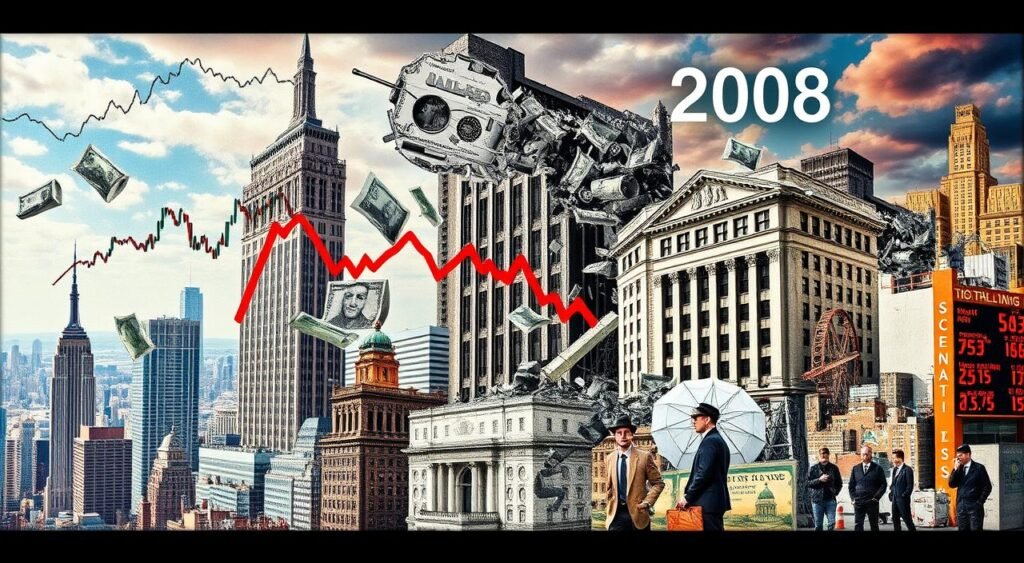About 70% of investors have lost money in a stock market crash. This shows how vital a good investment plan is for your portfolio. A stock market crash can be scary, especially for new investors. But, with the right approach, you can protect your money and even grow it.
It’s important to know what’s happening in the market and have a plan to keep your portfolio safe. This is especially true during a crash.
To get through a stock market crash, you need both short-term and long-term plans. This includes quick actions to protect your money and smart investment moves for when the market recovers. By keeping up with the market and adjusting your strategies, you can reduce losses and increase gains.
Key Takeaways
- Having a solid investment strategy is crucial to protect your portfolio during a stock market crash
- Understanding the current market situation is key to making informed investment decisions
- Portfolio protection is a top priority during a stock market crash
- Strategic investment moves can help position you for the recovery phase
- Staying informed and adapting your investment strategies can help minimize losses and maximize gains
- A stock market crash can be an opportunity for growth with the right investment strategies
Understanding the Current Stock Market Crash
To understand the stock market crash, we need to look at the main reasons behind it. We should check economic indicators like GDP, inflation, and unemployment. These help us see patterns and trends that affect the market.
Doing a deep market analysis is key. It helps investors make smart choices and adjust their plans. By knowing what causes the downturn, like trade issues or policy changes, investors can find ways to deal with the market’s ups and downs.
- Global economic trends and their impact on the stock market
- Industry-specific performance and potential areas of growth
- Company financials and management strategies
Key Indicators of Market Instability
It’s important to spot signs of market instability. We should watch economic signs like interest rates, commodity prices, and how people feel about spending. These help us see how volatile the market is and what risks there are.
Main Triggers of the Current Downturn
Knowing what causes the downturn is crucial. By looking at the reasons, investors can find growth chances. This helps them make better investment choices.
Global Economic Impact Assessment
Understanding the global impact of the crash is essential. We need to see how it affects different industries, countries, and areas. This helps us spot risks and chances that come with these changes.
Immediate Actions for Protecting Your Portfolio
To protect your portfolio during a stock market crash, take immediate action. Use risk management strategies like diversifying and reducing exposure to risky assets. This helps lessen the impact of market ups and downs.
A good portfolio protection plan mixes low-risk and high-risk investments. Include bonds, money market funds, stocks, and real estate. Also, think about hedging and dollar-cost averaging to shield against downturns.
- Reassessing your investment goals and risk tolerance
- Rebalancing your portfolio to maintain an optimal asset allocation
- Exploring alternative investment options, such as gold or other precious metals
By acting quickly and having a solid risk management plan, you can protect your portfolio. This prepares you for success, even when the market is uncertain.
Historical Perspective: Lessons from Previous Market Crashes
Looking at market history helps us understand how to deal with downturns. By studying past crises, we can learn to prepare and respond to market ups and downs. The 2008 financial crisis, for instance, was a major event that showed us the impact of such crises.
Recovering from a crash is often long and full of surprises. Yet, by studying how markets have bounced back, we can spot chances for growth. The dot-com bubble, which burst in the early 2000s, is another example of a crash followed by growth.
The 2008 Financial Crisis
The 2008 financial crisis was a global event that hit markets hard. It caused many banks and financial firms to face bankruptcy. The crisis was due to bad lending and too much debt.
Dot-com Bubble Insights
The dot-com bubble bursting in the early 2000s offers lessons on market history and recovery. It was fueled by too much speculation and overvalued tech stocks. After the crash, many companies came out stronger and more resilient.
Recovery Patterns and Timeframes
Recovery times and patterns differ with each crash and economic situation. By studying history and recovery, investors can find growth opportunities and plan for downturns. The key is to stay informed, adapt, and be patient.

Understanding market history, crises, and recoveries helps investors make better choices. Whether it’s the 2008 crisis or the dot-com bubble, each teaches us about the complex world of finance.
Strategic Investment Moves During Market Volatility
When the market is volatile, smart investment choices can really help your portfolio. Strategic investing means looking at the big picture, like market trends and sector performance. It also means spotting assets that might bounce back. This way, you can better handle market volatility and reach your financial goals.
To do well, it’s key to keep up with market news. Here’s how:
- Watch economic indicators and market news
- Look at how different sectors are doing and find new chances
- See which assets might recover
By being strategic, you can make smart investment moves. This helps you deal with market volatility and could lead to long-term gains. As the market changes, it’s important to be flexible and update your strategy.
Investing in a volatile market needs a good grasp of what’s driving trends. By staying informed and adjusting to changes, investors can make smart moves. This helps them meet their financial goals.
The Psychology of Surviving a Market Downturn
Going through a market downturn can be tough and emotionally draining. It’s key to understand the psychological side of investing. This helps make better choices and avoid common mistakes. Knowing how market psychology affects us can help us stay strong.
Managing Emotional Responses
Feelings like fear and anxiety can make us act without thinking. It’s important to handle these emotions well. This way, we can stay calm and make smart decisions.
By recognizing and managing our emotions, we can stay focused on our long-term goals.
Building Mental Resilience
Being mentally strong is vital during tough times. We can build this by growing our mindset, taking care of ourselves, and having a support network. This way, we can face market downturns and come out stronger.
Here are some ways to build mental resilience:
- Practice mindfulness and meditation
- Stay active with regular exercise
- Get support from loved ones or a counselor
By grasping market psychology, managing our emotions, and building resilience, we can handle market downturns better. This makes us more adaptable and robust.
Opportunities That Emerge During a Stock Market Crash
When a market crash happens, it’s key to see beyond the turmoil. Look for investment opportunities that can lead to long-term success. A smart strategic investing plan can help you find hidden gems in the market.
Some smart moves in past market crashes include:
- Buying dividend stocks known for steady payouts
- Investing in real estate or commodities
- Finding companies that are cheap but have strong potential
These choices can be the start of a solid investment strategy. They help build a portfolio that can weather any storm. With the right mindset and knowledge, a market crash can be a stepping stone to growth.
In the end, a market crash can spark a new era of strategic investing. It’s a chance to seize investment opportunities that others might miss. By staying alert and flexible, investors can make the most of any situation.
Conclusion: Positioning Yourself for the Recovery Phase
As the stock market starts to recover, it’s important to think ahead. Learn from past market crashes to face future challenges with confidence. This way, you can plan for long-term financial success.
Begin by checking your investment portfolio and financial goals. Look for areas that need updates to match the market and your changing needs. Think about spreading out your investments to reduce risk and look into new sectors that might grow during the recovery.
Keep in mind, the market’s recovery won’t happen overnight. Be patient and stay alert. If needed, get advice from experts and be ready to change your plans as the economy changes. By getting ready for the recovery, you can grab new chances and improve your financial future.

